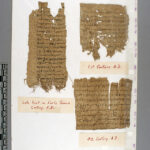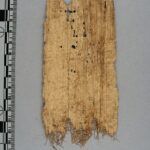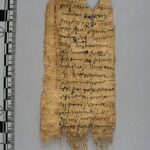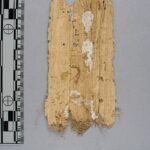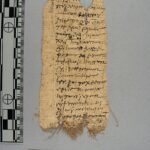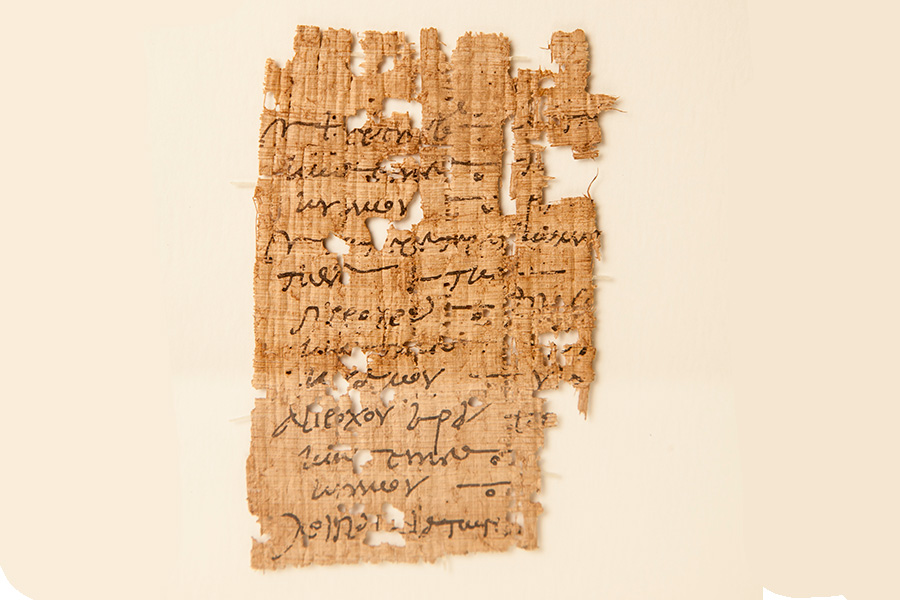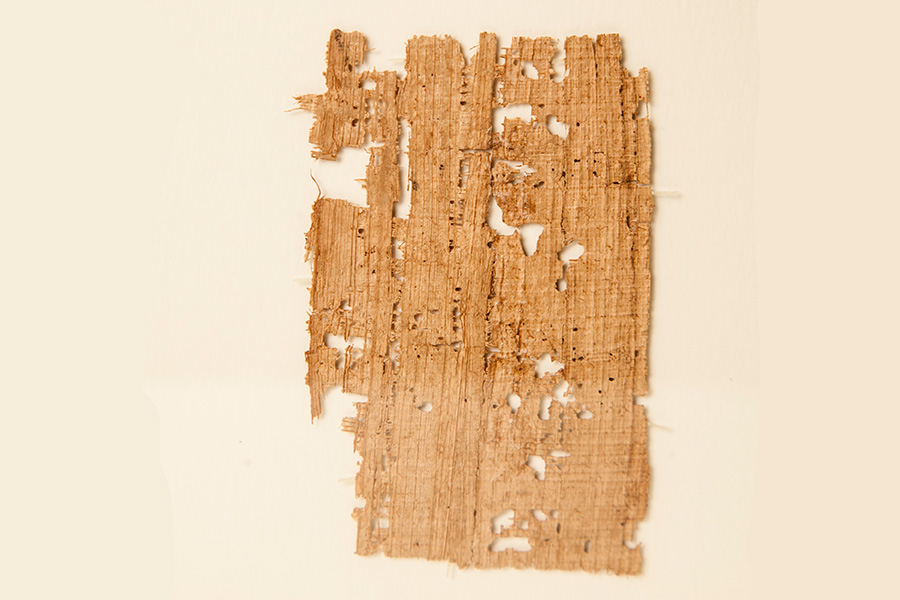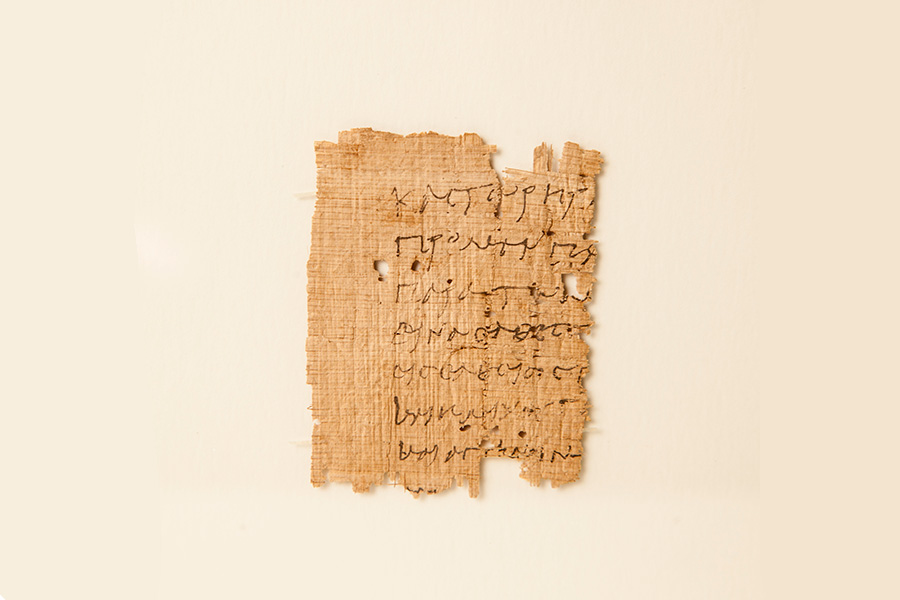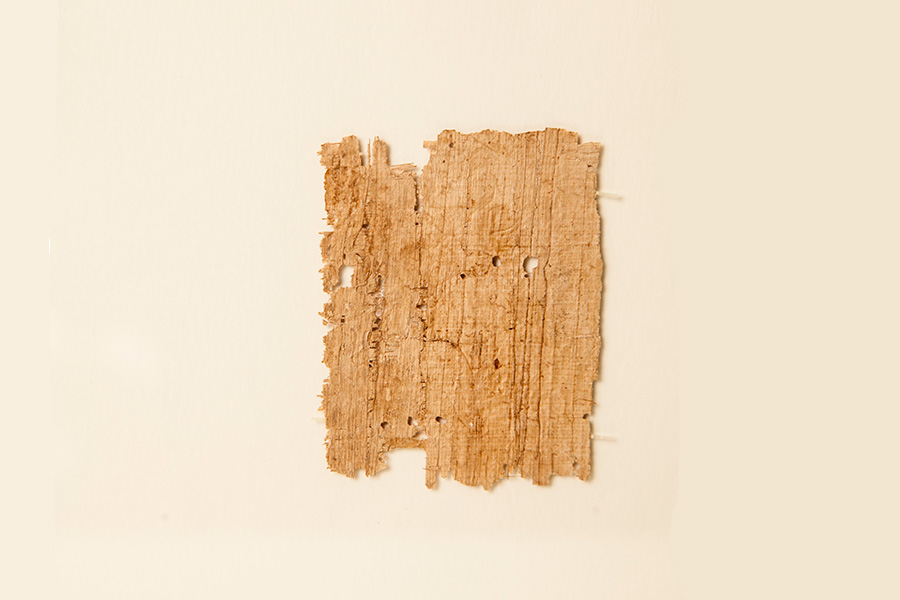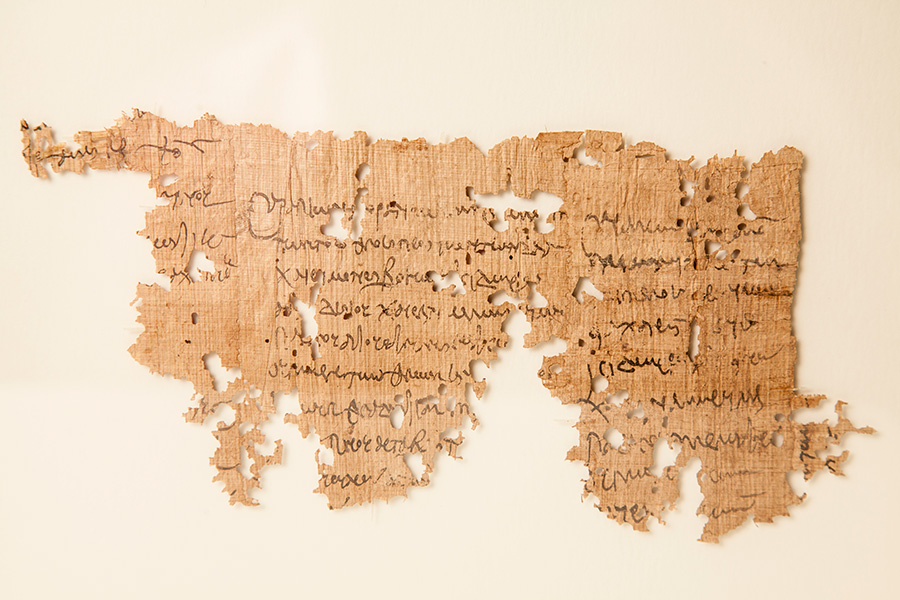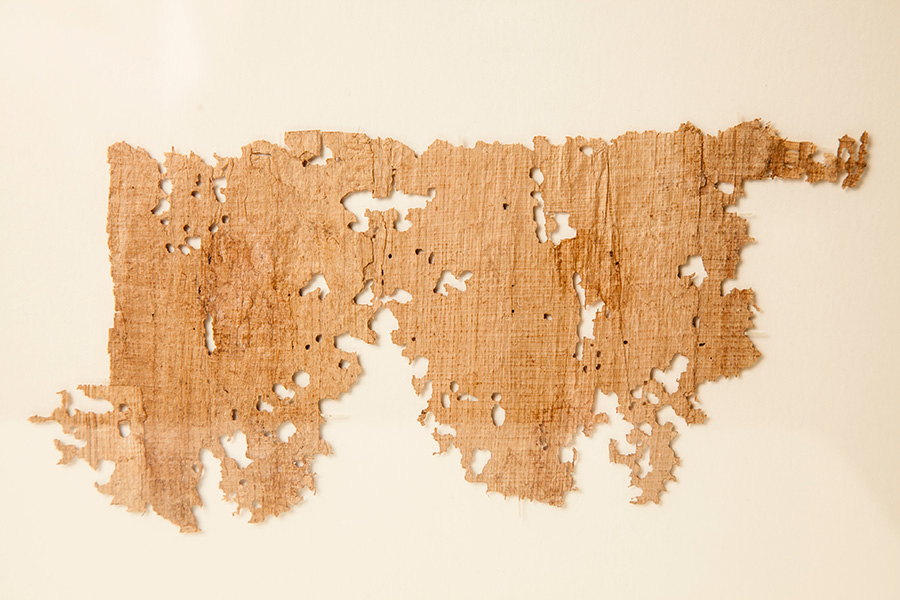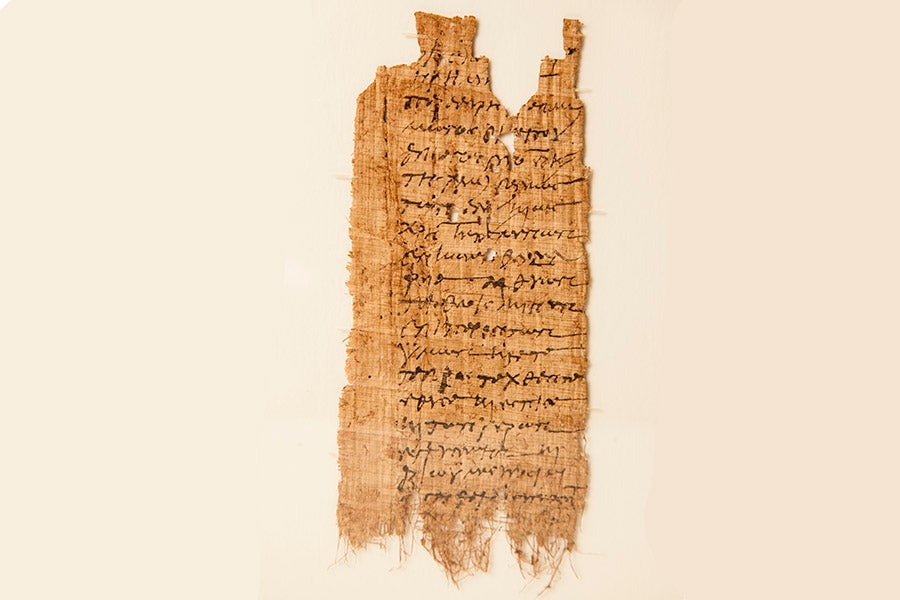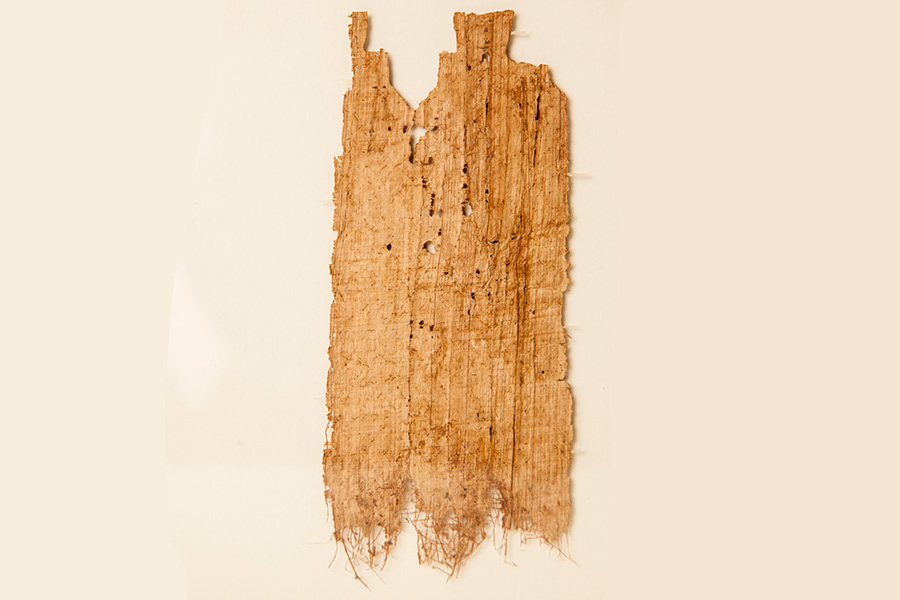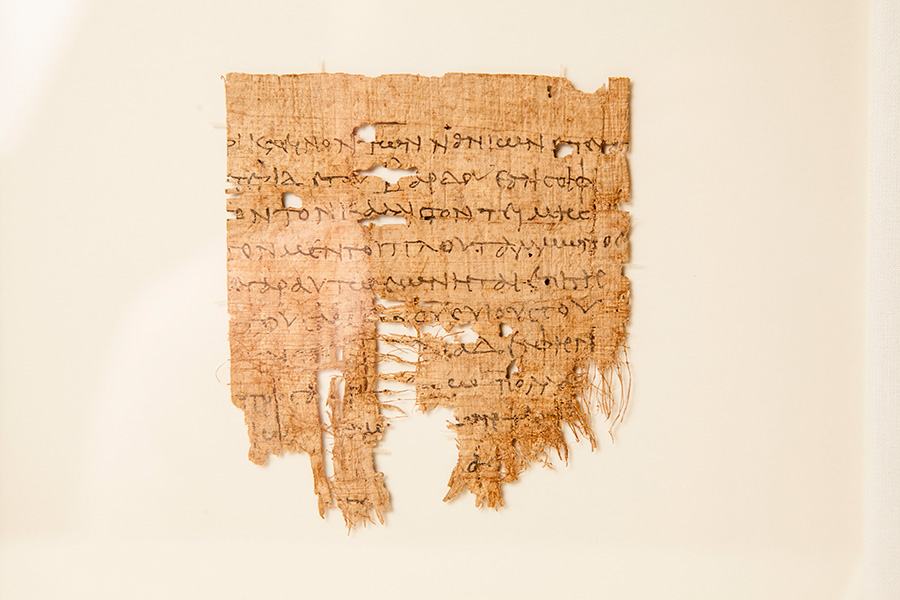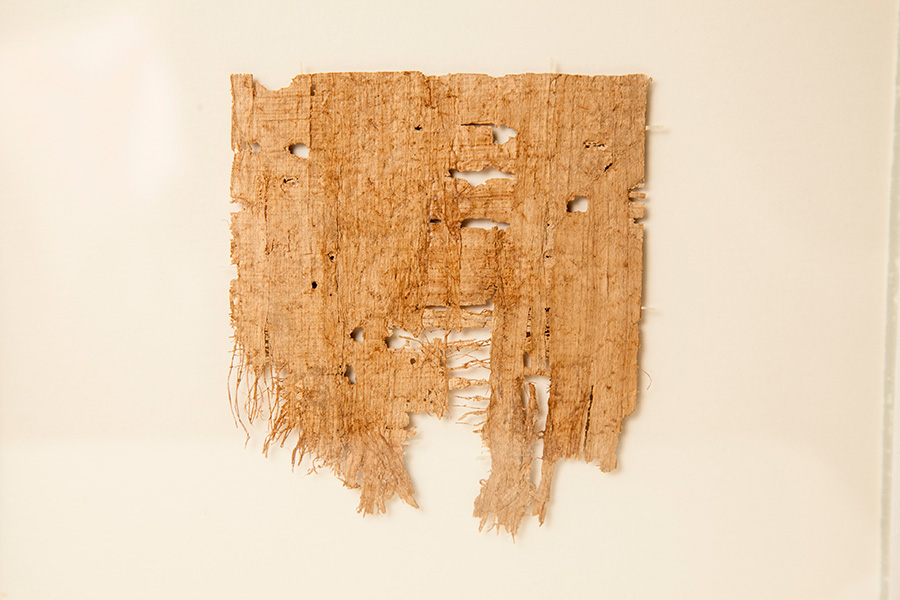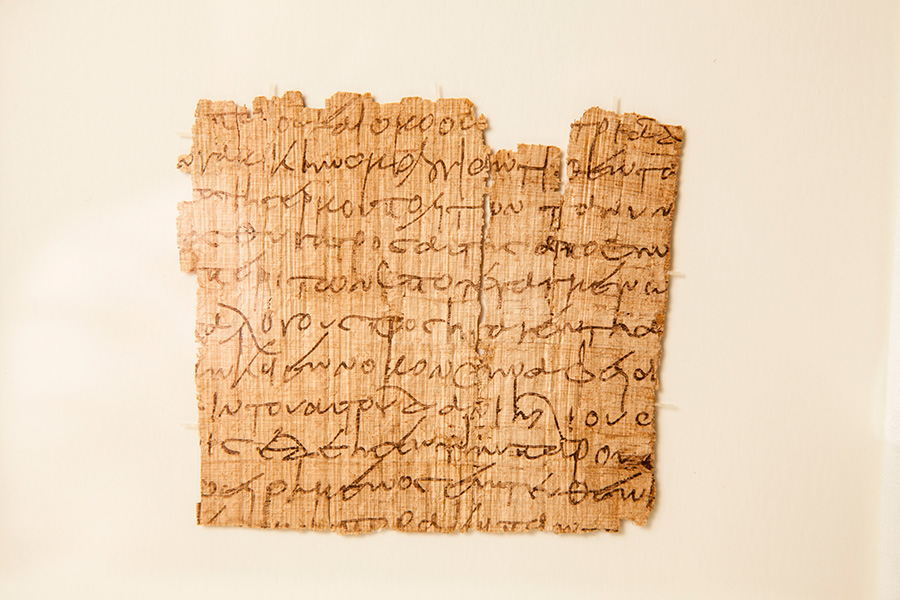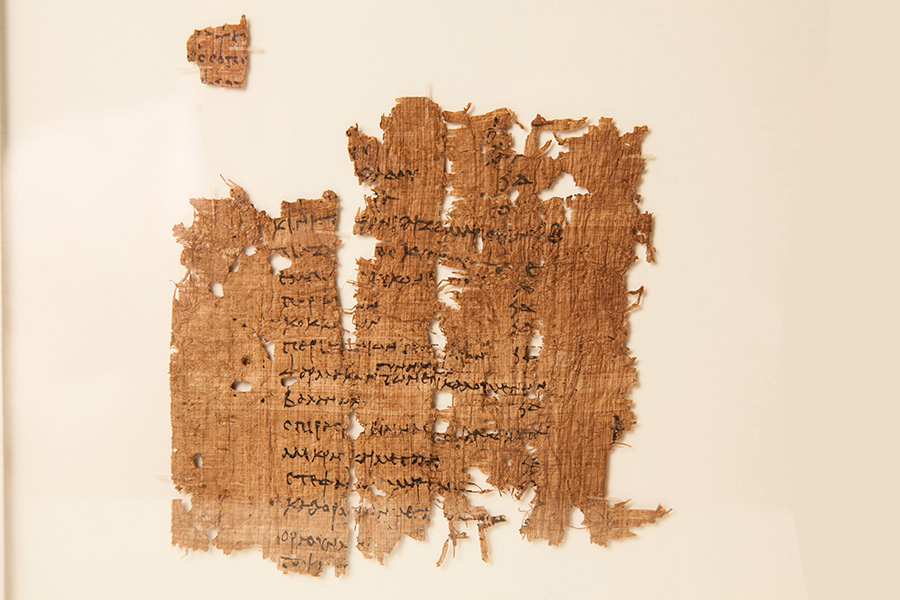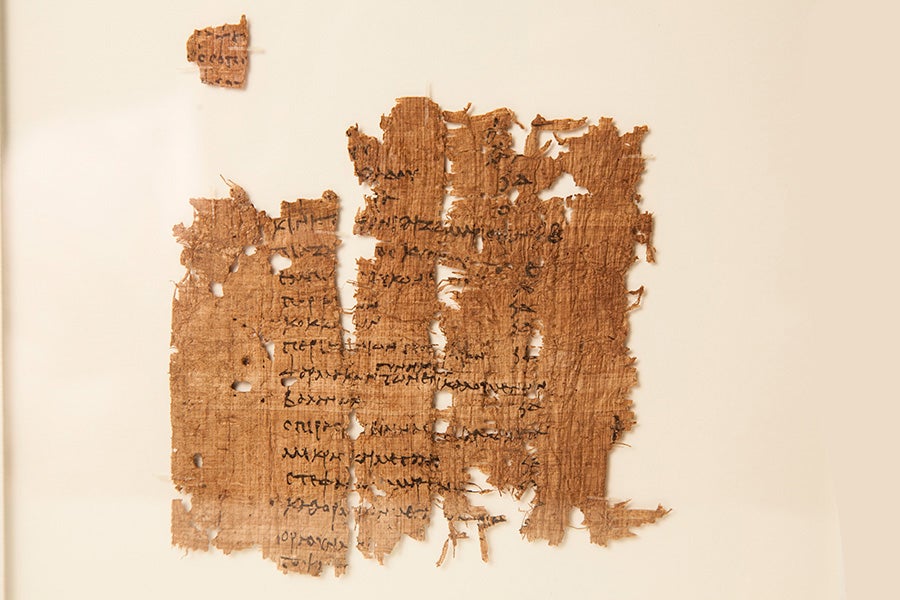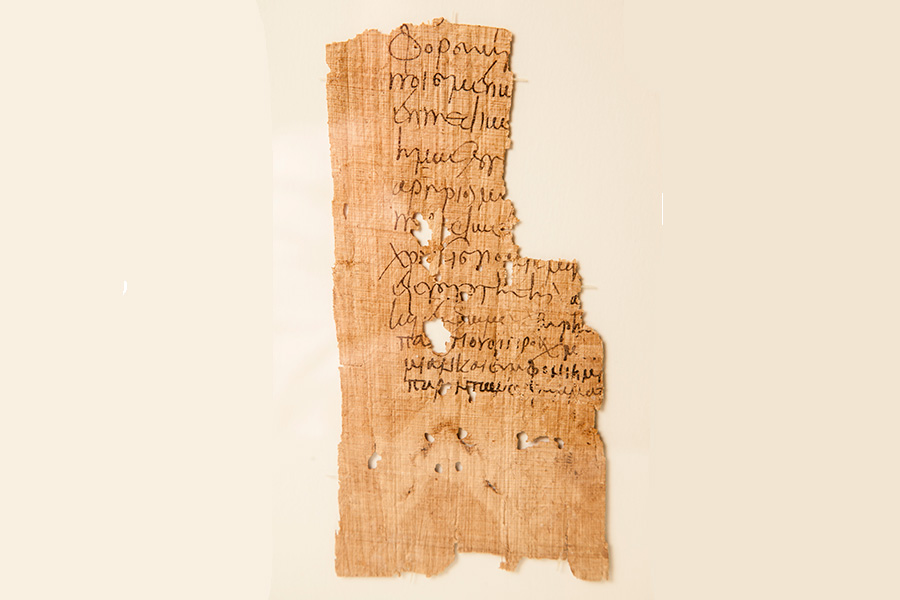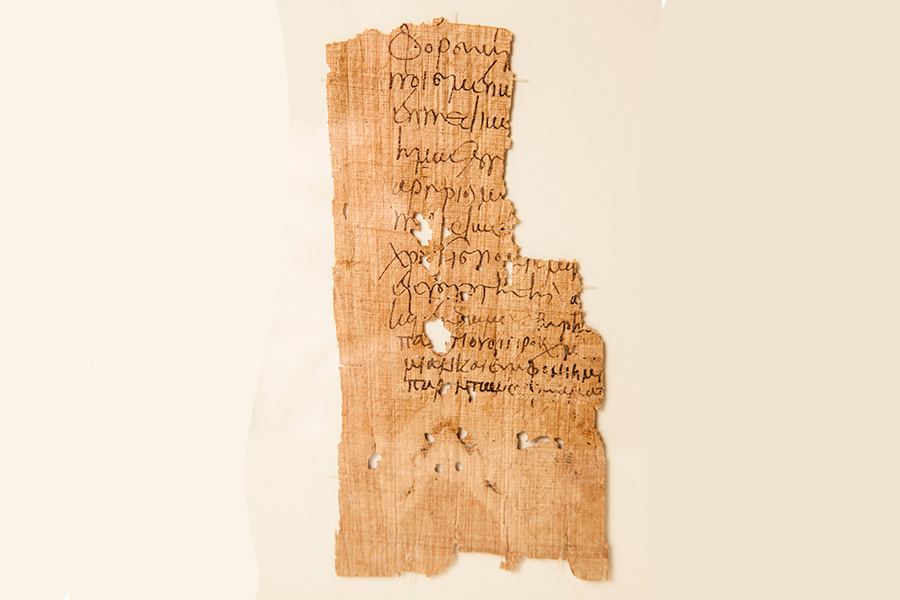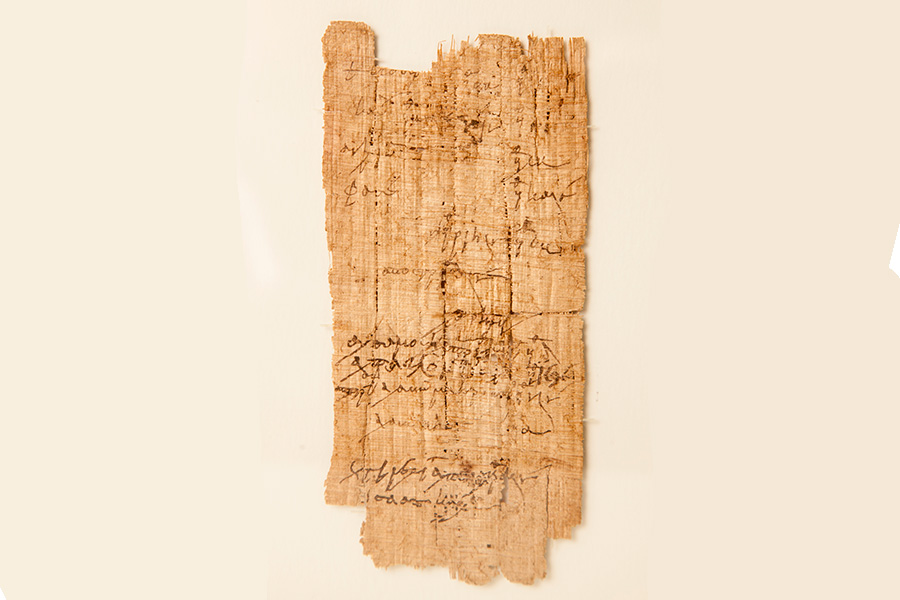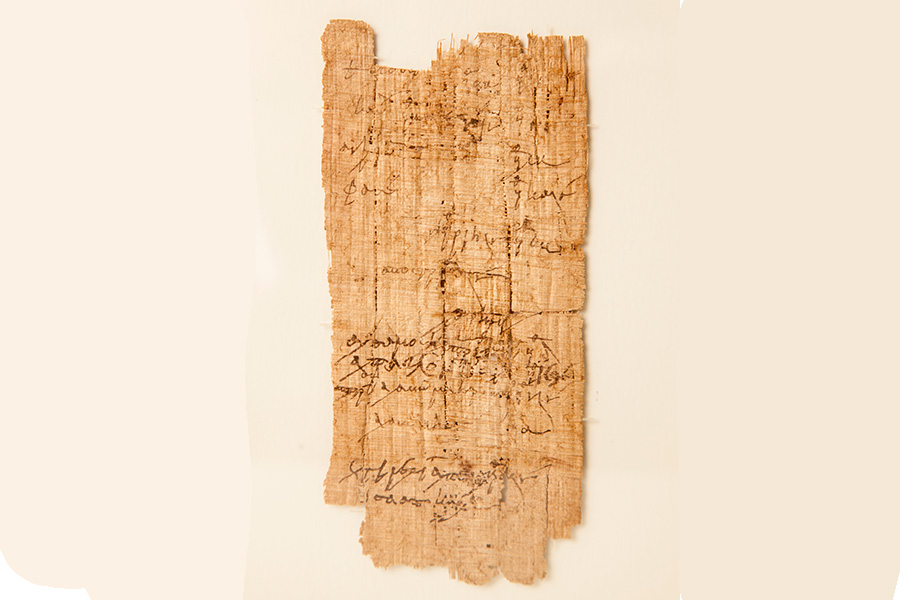Search the Archives
Contact Information
Hayley Jackson
College Archivist
Preus Library 310
Upper Floor
Luther College
700 College Drive
The Archives is open for research from 1:00-4:30, Monday-Friday, and by appointment.
archives@luther.eduPhone: 563-387-1805
The Orlando W. Qualley Papyrus Collection
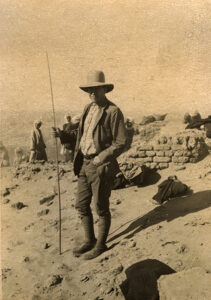 Orlando W. “Pip” Qualley, professor of classics and vice president of Luther College, spent the 1924-25 academic year in Egypt. He was on the staff of an archaeological project of the University of Michigan at a site named Karanis, a city of the ancient Roman period. During that year he purchased for Luther nine ancient papyrus fragments from an antiquities dealer in Cairo for use in his teachings. In 2014, these papyri were rediscovered in his collection during a special cataloging initiative in the Luther College Archives. The papyri underwent modern conservation at the University of Michigan and are now housed properly in glass and have been added to an international catalog of papyrus fragments.
Orlando W. “Pip” Qualley, professor of classics and vice president of Luther College, spent the 1924-25 academic year in Egypt. He was on the staff of an archaeological project of the University of Michigan at a site named Karanis, a city of the ancient Roman period. During that year he purchased for Luther nine ancient papyrus fragments from an antiquities dealer in Cairo for use in his teachings. In 2014, these papyri were rediscovered in his collection during a special cataloging initiative in the Luther College Archives. The papyri underwent modern conservation at the University of Michigan and are now housed properly in glass and have been added to an international catalog of papyrus fragments.
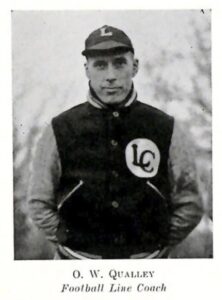
Orlando W. “Pip” Qualley (1897-1988) began his career at Luther College in 1912 when his parents advised him to attend the preparatory school. He attended Luther as a preparatory department student (similar to a high school student) and then afterwards as a college student. Qualley graduated in 1918 and then immediately began a Luther teaching career in the Classics department. A popular and talented teacher, he held this post for most of his life, even while simultaneously serving in other positions at the College.
Qualley received his MA in 1923 and his PhD in 1931, both from the University of Michigan. In 1924, he joined the University of Michigan excavation team to Karanis, Egypt, which is where he purchased the papyri that is held at the Luther College Archives.
Qualley was the first to hold the position of Dean at Luther College, serving from 1946-1964. He was also the first Vice President, a position to which he was appointed in 1936. He was Registrar for two periods, first from 1942 to 1946, and again from 1950 to 1956. Qualley also served as basketball and football coach. After he stepped down as Dean, he returned to teaching for five years before retiring in 1969.
Before his death in 1988, Qualley had donated his teaching and administrative files to the Luther College Archives. In addition to the papyri, The Papers of Orlando W. Qualley holds research material, administrative files, correspondence, and family memorabilia.
Qualley’s Work Log: 1924-1925
Throughout his year in Egypt, Qualley corresponded regularly with Clara Wollan, his future wife, who saved his letters until her death. Their daughter Eileen found the letters and gave them to A. Thomas Kraabel (Luther College Vice-President, Dean, and Classics Professor), suggesting that he might do something with them. Qualley’s letters to Clara were first and foremost love letters, but interspersed among his expressions of affection were extensive reports on his work on the project and daily life in Egypt. When excerpted, those reports constitute a detailed record of that first year of the archaeological project at the site of Karanis, Egypt, which we call Qualley’s Work Log. Qualley’s Work Log: 1924-1925 PDF

Dr. O. W. Qualley, photograph courtesy of Luther College Archives
By Wilfred F. Bunge
Luther College professor emeritus of religion and classics
What kept Pip Qualley at Luther College for 52 years (1918-1970)? He had made a significant enough impression in graduate school to move up in the academic world, had he chosen to do so. After his year on an archaeological project in Egypt (1924–25), his graduate school advisor invited him to continue on that project, but he declined. He was “going back to Luther,” he said. In fact, he was engaged to be married in August of 1925, a powerful draw for his return. He was besotted with love, and eagerly anticipated establishing a home in Decorah and enjoying a life of good work and wedded bliss. His correspondence with Clara Petra Wollan through the year of his sojourn in Egypt reveals his deep love and hopes for happiness in marriage.
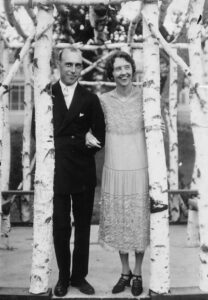
Orlando and Clara on the eve of their wedding.
He and Clara did marry, on August 20, 1925, in Glenwood, Minnesota, her home, and they chose Decorah as their shared home for the remainder of their lives. Pip did not to return to graduate school to complete his doctorate until 1930–31. In the meantime, he and Clara had two children, Eileen (born Sept. 21, 1927), who graduated with honors from Luther College and lived a vigorous and full life, and Paul (born prematurely on March 4, 1929), who died at birth. Clara, though she lived until age 88, was delicate throughout the couple’s married life. Her fragile health, Pip’s preoccupation with work, and their unfailing devotion to each other formed the fabric of their lives. At the same time, they lightened their lives and the lives of all who knew them with a playful spirit. The college’s motto, Soli Deo Gloria, was for them a happy, not somber, slogan.
Already in those early teaching years, Pip’s responsibilities were all consuming. He was a football line coach, with Hamlet Peterson as head coach, for 16 years, in addition to teaching a full class load. In those days, that could mean up to 15 hours of teaching per week. Soon to come were the Great Depression in the 1930s and World War II in the 1940s, which were devastating for the college. Only the dedication of persons like Pip could have gotten the college through, an amazing survival story.
Many promising faculty left the college over the difficult years of the 1930s, but Pip persisted, driven by his love for the college and the fellowship of like-minded colleagues. The college’s hardships were reflected in report of the North Central Association (NCA) accreditation team in 1937, which stated that by usual standards Luther should not be continued on the list of accredited institutions. However, the team detected the glimmer of a tradition of sound scholarship that led them to recommend continued accreditation nonetheless.
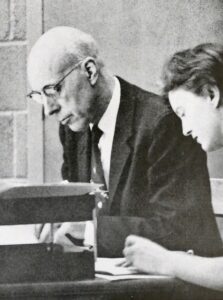
Dr. O. W. Qualley at work, Luther College Archives RG18
World War II followed closely on the heels of this accreditation visit. Qualley, who had earned a Ph.D. in 1931 and become the college’s first vice president in 1936, was largely responsible for shepherding the college through the difficult World War II years and the challenging postwar years, when enrollment climbed sharply with returning veterans. At the same time, he focused on raising the level of the faculty by encouraging completion of graduate study.
The NCA team visit of 1959 gave the college a very positive review. Qualley took great satisfaction in this since he saw it as vindication of his push for a better-prepared faculty and an education of high quality. By his retirement as dean in 1963, at the age of 66, the college had recovered its momentum, and he could retire with honor and dignity intact.
A summary of Qualley’s career at the college assembled after his retirement concludes with language that, though stated indirectly, echoes his own distinctive voice. “He had life-long treasured memories of his happy relationship with the faculty. They were imbued with the spirit of the college. Like the college itself, they had a sense of mission and deep commitment to its cause. In time of adversity such as the Depression, World War II, and the burning of Old Main, their faith, courage, and indomitable spirit, humanly speaking, carried the college through successfully to a greater opportunity for service. It was a team effort, an inspiration and enabling experience.”
In interviews in connection with his retirement as dean he confessed to “love” of Luther College. There were then two major loves in his life, Clara, his wife, and Luther College.
By Sasha Griffin
Interim College Archivist, 2014
Following the rediscovery of the papyri in January 2014, Luther College worked with the University of Michigan to treat and conserve the fragile documents. While kept for decades in plastic sleeves in an acid-free, archival folder and box, the pieces were in fairly good shape. However, they were vulnerable to bending, they needed to be cleaned up, and they needed to be re-housed in stable materials. Additionally, papyrologists identified that the dates that had been associated with each piece were inaccurate. Action was needed to conserve materials and have them properly examined and identified by experts.
In June 2014, the papyrus fragments were driven to the University of Michigan Preservation & Conservation department of the University Library. Conservator Marieka Kaye inspected the papyri and found that the papyri had been aggressively adhered to white paper. Over the course of the next two weeks, Kaye removed the papyri from the plastic sleeves, reduced the adhesive using acetone, humidified the fragments, repaired fibers, mounted the fragments between glass, and labeled each fragment.
Removing the papyri from the white paper was not only important from a preservation perspective, but it also led to some discovery. In the case of P. Luther 9, it had been unknown that the back of the papyrus had writing on it. Had the adhesive not been expertly reduced and then the fragment be properly cleaned, this may have never been discovered.
- Luther 4 – 6 had been glued to the same piece and side of paper.
- P.Luther 4: After treatment, back side (“verso”)
- P.Luther 4: After treatment, front side (“recto”)
- P.Luther 4: During treatment, back side (“verso”)
- P.Luther 4: During treatment, front side (“recto”)
The Luther College Archives holds the administrative and faculty files of Dr. Qualley. View the finding aid to learn more about what we have in his collection and to request to see the materials in person.
The Papers of Orlando W. Qualley (finding aid)
Karanis: An Egyptian Town in Roman Times – This book is published by the University of Michigan’s Kelsey Museum of Archaeology and is available at the Luther College Preus Library. This volume tells of the history and culture of Karanis, and also provides a useful introduction to the University of Michigan’s excavations between 1924 and 1935.
Karanis: An Egyptian Town in Roman Times
Karanis revealed: discovering the past and present of a Michigan excavation in Egypt – This book is published by the University of Michigan’s Kelsey Museum of Archaeology and is available at the Luther College Preus Library. This book summarizes the 2011-2012 exhibition “Karanis Revealed” and presents some of the new research that helped inspire it.
Karanis revealed: discovering the past and present of a Michigan excavation in Egypt (book)
Visit the website of the Classics Department to learn more about the academic offerings at Luther College and the benefits of studying Classics.
Papyri Images
The Papers of O.W. Qualley can be requested and viewed through the Norwegian-American Digital Catalog. The papyrus fragments are part of Box 6: Personal Papers.
Search the Archives
Contact Information
Hayley Jackson
College Archivist
Preus Library 310
Upper Floor
Luther College
700 College Drive
The Archives is open for research from 1:00-4:30, Monday-Friday, and by appointment.
archives@luther.eduPhone: 563-387-1805
